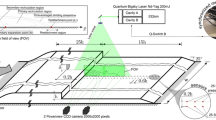Abstract
A small fence probe was evaluated for measurements in the time-dependent flow reversal region of the transition from boundary layer to separated flow. For moderate and high Reynolds numbers, the fence probe is demonstrated to be a usable tool for the measurement of the reverse flow associated with separation. Although the present probe pressure transducer system was limited to approximately 200 Hz, pulses of positive and negative shear stress were readily detected. At or near the location of zero surface shear stress, the measurements were limited by the signal-to-noise ratio. For the separated flow investigated, a marked reduction in the pressure gradient occurred when the fence probe indicated approximately 20 % reversal for the higher Reynolds numbers. The reversal increased to 24 % for the lower Reynolds numbers. The measurements indicate that flow reversal alone may not be adequate to identify the degree of separation. Upstream of turbulent boundary layer (intermittent) separation, the duration of the reversed shear stress was found to be very short (0.002–0.007 s), suggesting a local, small-scale, impulse-type separation. At and beyond the location of intermittent separation, the shear stress reversal duration was an order of magnitude longer. Estimates of the maximum and minimum surface shear stress in the separation region were also obtained with the fence probe.
















Similar content being viewed by others
Abbreviations
- c f :
-
Skin friction coefficient \(\frac{\tau_w}{\frac{1}{2}\rho U^2_ e}\)
- c p,o :
-
Pressure coefficient \(\frac{p-p_o}{\frac{1}{2}\rho U_{\rm {ref}}^2}\)
- d :
-
Test section height
- G :
-
Clauser’s integral shape parameter \(\frac{1}{\Updelta} \int_0^\infty \left(\frac{U_e-U}{U_\tau}\right)^2{\rm d}y\)
- h :
-
Fence height
- h * :
-
Non-dimensional fence height \(\frac{h U_\tau}{\nu}\)
- H :
-
Velocity profile shape factor δ*/θ
- n :
-
Coordinate across the boundary layer
- p :
-
Static pressure
- p o :
-
Static pressure at minimum cross-section
- \(\Updelta p\) :
-
Pressure difference across the fence
- \(\Updelta p^+\) :
-
Non-dimensional pressure difference \(\frac{\Updelta p h^2}{\rho\nu^2}\)
- Re/m :
-
Reference Reynolds number per meter at tunnel inlet
- R θ :
-
Momentum thickness Reynolds number
- S :
-
Mean zero surface shear stress correlation, Eq. 2
- s :
-
Coordinate along the test wall
- U :
-
Mean velocity
- U e :
-
Mean velocity at the edge of the boundary layer
- U τ :
-
Shear stress velocity \(\sqrt{\frac{\tau_w}{\rho}}\)
- U * :
-
Wall similarity velocity \(\frac{U}{U_\tau}\)
- y * :
-
Wall similarity coordinate \(\frac{y U_\tau}{\nu}\)
- δ* :
-
Displacement thickness \(\int_0^\infty \left(1-\frac{U}{U_e}\right){\rm d}y\)
- \(\Updelta\) :
-
Clauser’s integral parameter \(\int_0^\infty \frac{U_e-U}{U_\tau}{\rm d}y\)
- ρ:
-
Mass density
- θ:
-
Momentum thickness \(\int_0^\infty \frac{U}{U_e}\left(1-\frac{U}{U_e}\right){\rm d}y\)
- τ w :
-
Surface shear stress
- τ + w :
-
Non-dimensional surface shear stress \(\frac{\tau_w h^2}{\rho\nu^2}\)
- ν:
-
Kinematic viscosity
References
Cassel KW (2000) A comparison of Navier-Stokes solutions with the theoretical description of unsteady separation. Philos Trans Royal Soc Lond A 358:3207–3227
Clauser FH (1954) Turbulent bounder layers in adverse pressure gradients. J Aeronaut Sci 21(2):91–108
Fernholz HH, Janke G, Schober M, Wagner PM, Warnock D (1996) New developments and applications of skin-friction measuring techniques. Meas Sci Tech 7:1396–1409
Haller G (2004) Exact theory of unsteady separation for two-dimensional flow. J Fluid Mech 512:257–311
Ludwieg H, Tillman W (1950) Investigation of the wall shearing stress in turbulent boundary layers. NACA TM 1285
McLaughlin DK, Tiederman W (1973) Biasing correction for individual realization of laser anemometer measurements in turbulent flow. Phys Fluids 16(12):2082–2088
Sandborn VA (2003) Reynolds number correlations for separated turbulent boundary layers. AIAA J 41(4):744–747
Sandborn VA (2008) Near surface velocity distributions for intermittent separation of turbulent boundary layers. J Fluid Eng 130(4):041203-1–4
Sandborn VA, Kline SJ (1961) Flow models in boundary layer stall inception. J Basic Eng 83(3):317–327
Sandborn VA, Liu CY (1968) On turbulent boundary layer separation. J Fluid Mech 23(2):293–301
Schober RI, Obermeier E, Pirskawetz S, Fernholz HH (2004) A MEMS skin friction sensor for time resolved measurements in separated flow. Exp Fluids 36:593–599
Simpson RL (1989) Turbulent boundary layer separation. Ann Rev Fluid Mech 21:205–234
Simpson RL, Strickland JH, Barr KPW (1974) Laser and hot film anemometer measurements in a separating boundary layer. Report No. WT-3, NTIS AD-Ao0115. Thermal and Fluid Science Center. Southern Methodist University
Simpson RL, Chew XT, Shivaprasad BG (1980) Measurements of a separating boundary layer. Project SQUID, Report No. SMU-4-PU, NTIS AD-Ao09525213
Author information
Authors and Affiliations
Corresponding author
Rights and permissions
About this article
Cite this article
Sandborn, V.A., Seong, S.H. Fence probe measurement of flow reversal in separating turbulent boundary layers. Exp Fluids 53, 391–399 (2012). https://doi.org/10.1007/s00348-012-1295-3
Received:
Revised:
Accepted:
Published:
Issue Date:
DOI: https://doi.org/10.1007/s00348-012-1295-3




